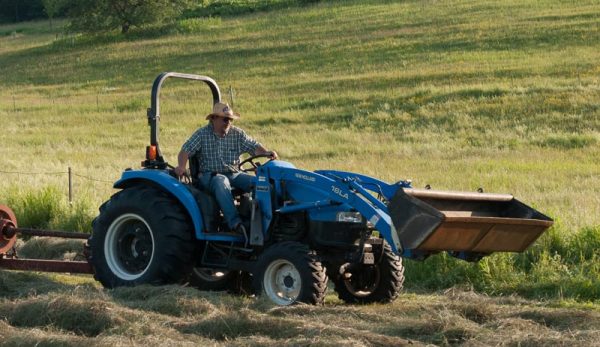
A front-end loader is one of the most useful attachments a tractor can have. They’re suitable for a wide variety of tasks (moving compost and manure, clearing snow, etc.) and can save a lot of time and effort.
But just because a front-end loader is a great tool doesn’t mean every farmer needs one. Sure, a front-end loader can tackle a lot of tasks. And augmenting the bucket with other tools (like forks or a grapple) can further expand its usefulness.
But if your farming projects don’t frequently require the use of a front-end loader, the expense of such an attachment might be better invested elsewhere.
When You Might Not Need a Front-End Loader
Let’s ponder some examples. A front-end loader isn’t a prerequisite for baling hay. The required implements (mower/conditioner, tedder, hay rake, baler, etc.) are typically towed behind the tractor. They receive power as needed from the PTO and hydraulics.
You don’t need a one for mowing and brush hogging, either. Or for plowing fields.
Many of the most stereotypical farming tasks involving field cultivation do not need the service of a front-end loader, aside from the possibility of the loader counterbalancing the weight of heavy rear implements on a small tractor.
But a similar effect can be achieved with weights mounted on the front of the tractor.
Read more: Check out these 5 ways to counterbalance your tractor!
Can You Do the Job by Hand Instead?
Even if you can envision a use for a front-end loader, it’s fair to ask, is the job manageable to complete by hand?
Let’s say you have a garden and fill a few raised beds per year with compost from an old manure pile. It would certainly be fast and easy to fill the beds with a few scoops from the bucket of a front-end loader.
But if you’re only filling a few beds, it doesn’t take much longer to shovel compost by hand into boxes. Then you can pull them via wagon to the garden site.
Sure, this does require more effort. But it can also be a more thorough approach, since it provides an opportunity to pick weeds and roots out of the compost before it enters the beds. It’s difficult to be choosy when moving compost by the bucket load with a front-end loader.
You may have to clean weeds and roots out the beds after you’ve filled them.
Read more: How much soil do you need for your raised beds? This will help you calculate the amount.
A Matter of Scale
Now, the point here isn’t to give the impression front-end loaders are overrated—they’re certainly not. Instead, it’s to argue that—in some cases—a front-end loader isn’t as critical as you might think.
Many tasks are unaffected by the absence of this attachment. And others you can accomplish through manual labor if you just put in the time and effort.
Ultimately, it comes down to scale. If you’re debating whether to purchase a front-end loader for your tractor, make a list of every project you can envision tackling that would benefit from the loader (or the forks, or the grapple).
Then carefully ponder the scope of each project. Are you going to move a small wagonload or two of compost for your garden beds each year? You can probably manage it by hand.
But 50 wagonloads? If the scope of your project is expansive enough, then a front-end loader—expensive or not—might be the right investment.




